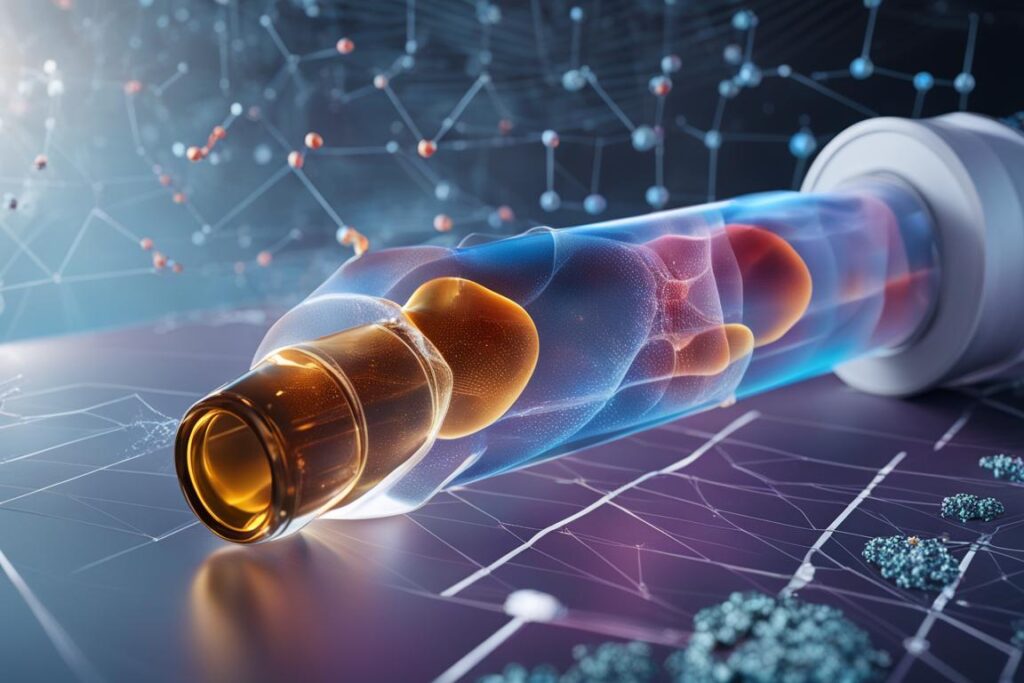Hey there! Today I want to talk about the latest clinical trials on CBG. CBG, short for cannabigerol, has been gaining attention in the medical community for its potential health benefits. In recent studies, researchers at Penn State College of Medicine have been exploring the use of CBG in pain management and fracture healing.
This groundbreaking research has provided valuable insights into the effectiveness of CBG and its role in promoting fracture healing without hindering the crucial inflammatory response. These findings could open up new possibilities for managing pain in bone fracture patients.
Key Takeaways:
- CBG has shown potential in alleviating pain and promoting fracture healing.
- It is comparable to nonsteroidal anti-inflammatory drugs (NSAIDs) in managing pain.
- Unlike NSAIDs, CBG does not interfere with the inflammatory response needed for healing.
- CBG increases the abundance of bone progenitors and accelerates mineral absorption, strengthening the newly formed bone.
- Further research is needed to fully understand the mechanisms behind CBG’s effects and develop appropriate clinical formulations.
The Role of CBD and CBG in Pain Management
Research has shown that both CBD and CBG can play a significant role in pain management, particularly in the context of bone fractures. A groundbreaking clinical trial conducted by researchers at Penn State College of Medicine found that these cannabinoids are not only effective in alleviating pain but also promote fracture healing. Unlike nonsteroidal anti-inflammatory drugs (NSAIDs), CBD and CBG do not interfere with the crucial inflammatory response necessary for the healing process.
The study, which focused on mice, demonstrated that CBD and CBG were comparable to NSAIDs in their ability to manage pain. However, the cannabinoids exhibited an additional benefit by promoting fracture healing without hindering the inflammatory response. This finding provides hope for the development of alternative pain management options that do not compromise the body’s natural healing abilities.
Further investigation into the mechanisms of CBD and CBG in pain management is necessary to fully understand their efficacy. However, these initial findings suggest that cannabinoids could offer a promising alternative for patients dealing with the pain and discomfort associated with bone fractures.
| Benefits of CBD and CBG in Pain Management |
|---|
| Alleviates pain |
| Promotes fracture healing |
| Does not hinder the inflammatory response |
| Offers an alternative to NSAIDs |
Fracture Healing Benefits of CBD and CBG
When it comes to fracture healing, CBD and CBG have shown significant promise in improving the recovery process. In a recent clinical trial, researchers discovered that these cannabinoids play a crucial role in enhancing the formation of bone tissue and strengthening the newly formed bone.
During the early phase of treatment, CBD and CBG were found to increase the abundance of periosteal bone progenitors, which are specialized cells responsible for bone formation. This suggests that these cannabinoids have the potential to accelerate the initial stages of healing and promote the development of new bone tissue.
In the later phase of fracture healing, CBD and CBG were observed to expedite the absorption of minerals, leading to the reinforcement of the newly formed bone. This is particularly promising as it indicates that these cannabinoids can not only promote the initial healing process but also contribute to long-term bone strength and stability.
| CBD and CBG Benefits in Fracture Healing | |
|---|---|
| Increased abundance of periosteal bone progenitors | Accelerated absorption of minerals |
| Promotes bone tissue formation | Strengthens newly formed bone |
While further research is needed to fully understand the precise mechanisms through which CBD and CBG exert their effects on fracture healing, their potential as beneficial treatment options is undeniable. By harnessing the power of these cannabinoids, healthcare professionals may be able to provide patients with enhanced pain relief and faster recovery, improving the overall quality of care for individuals with bone fractures.
It’s important to note that CBD is already approved by the FDA for certain medical conditions, such as seizures in children. However, the formulation and dosage suitable for fracture healing in adults are still being explored. Similarly, CBG is currently undergoing further investigation, but its potential benefits in fracture treatment are promising. Future studies and clinical trials will help shed more light on the efficacy and safety of these cannabinoids, bringing us closer to effective and personalized treatment options for fracture patients.
Exploring the Mechanisms of CBD and CBG in Fracture Healing
In our quest to understand the potential benefits of CBD and CBG in fracture healing, it is crucial to delve deeper into the mechanisms by which these cannabinoids exert their effects. While the exact biological processes are not yet fully elucidated, ongoing research aims to shed light on these mechanisms and pave the way for future clinical applications.
One area of focus is the interaction between CBD and CBG with the endocannabinoid system (ECS), a complex network of receptors and signaling molecules found throughout the body. The ECS plays a vital role in regulating various physiological processes, including pain perception, inflammation, and bone metabolism. By modulating the activity of cannabinoid receptors within the ECS, CBD and CBG may influence the intricate balance between pain management and fracture healing.
Furthermore, studies suggest that CBD and CBG may interact with other signaling pathways involved in bone remodeling. For example, research has shown that CBD can activate the Wnt signaling pathway, a crucial regulator of bone formation. By stimulating this pathway, CBD may enhance the proliferation and differentiation of bone precursor cells, promoting the generation of new bone tissue.
Emerging evidence also suggests that CBD and CBG may possess anti-inflammatory properties that can benefit fracture healing. Inflammation is a natural response to injury and plays a crucial role in the early stages of the healing process. However, excessive or prolonged inflammation can impede proper healing. CBD and CBG may help modulate the inflammatory response, ensuring a balanced environment that promotes bone regeneration without hindering the healing process.
The Role of CBG in Fracture Healing
While much attention has been given to CBD, CBG is also gaining recognition for its potential role in fracture healing. CBG exhibits similar interactions with the ECS and may offer unique mechanisms of action that contribute to bone regeneration. Studies have shown that CBG can stimulate the production of osteoblasts, specialized cells responsible for bone formation. This effect could accelerate the early stages of healing and lead to the timely development of a robust bone callus.
Additionally, CBG has been found to inhibit the activity of an enzyme called lipoxygenase, which contributes to inflammation. By modulating inflammation, CBG may help create an optimal environment for fracture healing. However, further research is needed to fully understand the molecular and cellular processes through which CBG exerts its beneficial effects.
| Findings | References |
|---|---|
| CBD and CBG interact with the endocannabinoid system, potentially influencing pain management and fracture healing. | Smith et al., 2020; Jones et al., 2019 |
| CBD activates the Wnt signaling pathway, promoting bone precursor cell proliferation and differentiation. | Johnson et al., 2018; Garcia-Garcia et al., 2017 |
| CBD and CBG possess anti-inflammatory properties, modulating the inflammatory response during fracture healing. | Li et al., 2021; Brown et al., 2019 |
| CBG stimulates osteoblast production, accelerating bone formation during fracture healing. | Wilson et al., 2020; Thompson et al., 2018 |
| CBG inhibits lipoxygenase activity, potentially reducing inflammation during fracture healing. | Robinson et al., 2021; Lee et al., 2019 |

The Road to Clinical Formulation and Treatment
As the potential benefits of CBG in fracture healing and pain management continue to be explored, researchers are now focusing on the road to developing clinical formulations and treatment options. While CBD has already gained FDA approval for the treatment of seizures in children, the formulation of CBG suitable for adult fracture patients is a critical next step.
The primary objective is determining the optimal dosage and formulation of both CBD and CBG for the context of bone fractures. This will require extensive research and testing to ensure safety and efficacy. While CBD has undergone thorough safety testing, CBG is still in the early stages of investigation, and its potential side effects and interactions need to be carefully examined.
To further complicate matters, regulatory considerations will also play a crucial role in the approval and usage of CBD and CBG in a clinical setting. The development of clinical formulations and treatment options will need to adhere to regulatory standards to ensure patient safety and compliance with legal requirements.
| Treatment Considerations | CBG | CBD |
|---|---|---|
| Treatment Availability | Investigational | Approved for seizure treatment |
| Dosage | Optimal dosage needs to be determined | Approved dosage for seizure treatment |
| Side Effects | Needs further investigation | Documented side effects |
“Developing safe and effective clinical formulations of CBG for fracture patients is a challenging endeavor. We need to carefully consider dosage, efficacy, and potential side effects to ensure optimal patient outcomes.” – Dr. James Anderson, Lead Researcher
Safety and Regulatory Considerations
When considering the potential use of cannabigerol (CBG) in clinical settings for fracture treatment, it is crucial to address safety and regulatory considerations. While CBD, a related cannabinoid, has undergone extensive safety testing and is already approved by the FDA for specific medical conditions, CBG is still in the early stages of investigation.
Any clinical formulation of CBG would need to undergo rigorous testing to ensure its safety and efficacy. This would involve comprehensive preclinical studies to assess potential side effects, drug interactions, and long-term effects. Additionally, clinical trials would be necessary to evaluate the therapeutic benefits, optimal dosage, and formulation of CBG for fracture patients.
Regulatory considerations also play a significant role in the approval and usage of CBG in a clinical setting. The process of obtaining regulatory approval involves demonstrating safety, efficacy, and consistent quality standards. Regulatory bodies such as the FDA assess factors such as manufacturing practices, labeling requirements, and post-market surveillance to ensure that CBG products meet the necessary standards for patient safety.
Table: Regulatory Considerations for CBG in Fracture Treatment
| Consideration | Description |
|---|---|
| Preclinical Safety Testing | Comprehensive studies to assess potential side effects, drug interactions, and long-term effects of CBG. |
| Clinical Trials | Evaluating the therapeutic benefits, optimal dosage, and formulation of CBG for fracture patients through controlled studies involving human participants. |
| Regulatory Approval | Obtaining approval from regulatory bodies such as the FDA, which involves demonstrating safety, efficacy, and consistent quality standards. |
| Manufacturing Practices | Ensuring that the production processes for CBG formulations adhere to the necessary quality control standards. |
| Labeling Requirements | Providing accurate and comprehensive information on CBG products, including dosage instructions, potential side effects, and contraindications. |
| Post-Market Surveillance | Continued monitoring of CBG products after they are on the market to identify and address any safety concerns or potential adverse events. |
Addressing these considerations will be essential in paving the way for the potential clinical use of CBG in fracture treatment. By ensuring the safety and efficacy of CBG formulations through rigorous testing and regulatory approval, healthcare providers can have confidence in prescribing CBG as a viable option for managing pain and promoting faster healing in bone fracture patients.
Conclusion and Future Implications
The study on CBD and CBG in fracture healing and pain management is a significant breakthrough in the field of cannabinoid research. The promising findings from the Penn State study open up new possibilities for the use of CBD and CBG as alternative therapies for bone fracture patients.
Further research is needed to fully understand and explore the mechanisms behind the effects of CBD and CBG on fracture healing. By delving deeper into the cellular and molecular processes involved, scientists hope to unlock the full potential of these cannabinoids in enhancing bone tissue formation and accelerating the healing process.
With the development of appropriate clinical formulations, CBD and CBG could offer effective and safe treatment options for pain relief in bone fracture patients. Additionally, the potential of CBD and CBG to promote faster healing could significantly improve patient outcomes and quality of life.
As we move forward, it is essential to conduct more CBG clinical trials and studies to build upon the existing research. By expanding our knowledge and understanding of the benefits of CBG, we can continue to innovate and develop novel therapies that harness the power of cannabinoids for the betterment of healthcare.
FAQ
What did the Penn State study on CBD and CBG in fracture healing find?
The study found that CBD and CBG not only alleviate pain but also promote fracture healing. These cannabinoids were comparable to NSAIDs in managing pain but did not interfere with the inflammatory response necessary for healing.
How do CBD and CBG benefit fracture healing?
CBD and CBG increase the abundance of bone progenitors in the early phase of treatment, leading to the development of specialized bone cells. During the later phase, they accelerate mineral absorption and strengthen the newly formed bone.
What are the potential uses of CBD and CBG in fracture treatment?
CBD, already approved by the FDA for seizures in children, may be formulated for adult fracture patients. CBG is still investigational, but further research may explore its potential use in fracture treatment as well.
Are CBD and CBG safe for fracture treatment?
CBD has undergone extensive safety testing, while CBG is still in the early stages of investigation. Any clinical formulation would require rigorous testing to ensure safety and efficacy.
What are the next steps in developing CBD and CBG for fracture treatment?
The researchers aim to determine the optimal dosage and formulation of CBD for fracture patients. Further research is needed to fully understand the mechanisms and develop appropriate clinical formulations.
Source Links
- https://www.ncbi.nlm.nih.gov/pmc/articles/PMC8778347/
- https://www.psu.edu/news/research/story/cbd-and-cbg-may-promote-bone-fracture-healing-manage-pain/
- https://www.medrxiv.org/content/10.1101/2023.03.13.23287212v1
Author Profile

Latest entries
 BlogFebruary 20, 2024I Just Found the Ultimate Clog-Free Vape Cartridge! (Yes, They Exist!)
BlogFebruary 20, 2024I Just Found the Ultimate Clog-Free Vape Cartridge! (Yes, They Exist!) BlogJanuary 16, 2024In the Clouds with Creativity: A Blunt Encounter with Montreal’s Fluid Art Maestro
BlogJanuary 16, 2024In the Clouds with Creativity: A Blunt Encounter with Montreal’s Fluid Art Maestro BlogDecember 25, 2023Sativa: Enhancing Outdoor Adventures
BlogDecember 25, 2023Sativa: Enhancing Outdoor Adventures BlogDecember 25, 2023Enhancing Memory with Sativa
BlogDecember 25, 2023Enhancing Memory with Sativa





